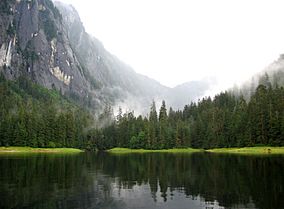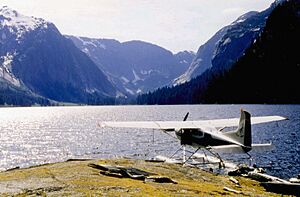Misty Fjords National Monument facts for kids
Quick facts for kids Misty Fjords National Monument |
|
|---|---|
|
IUCN Category Ib (Wilderness Area)
|
|

One of the thousands of ocean inlets at Misty Fiords.
|
|
| Location | Ketchikan Gateway Borough, Alaska, United States |
| Nearest city | Ketchikan, AK |
| Area | 2,294,343 acres (9,246 km2) |
| Established | December 1, 1978 |
| Governing body | U.S. Forest Service |
The Misty Fjords National Monument (also called Misty Fiords National Monument) is a special place in Alaska. It is a national monument and a wilderness area. The U.S. Forest Service looks after it as part of the huge Tongass National Forest.
Misty Fjords is about 40 miles (64 km) east of Ketchikan. It is located along the beautiful Inside Passage coast in southeastern Alaska. This monument covers a massive 2,294,343 acres (9,246 km2) of land. Most of this area is protected as wilderness, meaning it is kept wild and untouched.
In 1978, President Jimmy Carter declared this area a national monument. This helped protect its amazing natural beauty. Later, in 1980, a law called the Alaska National Interest Lands Conservation Act officially made it the Misty Fjords National Monument. This law also set aside a small part of the monument for a special mineral called molybdenum. This area might hold the world's largest deposit of this important metal.
Contents
Exploring Misty Fjords' Amazing Landscape
Misty Fjords is famous for its stunning natural features. It has deep valleys, tall cliffs, and many waterways. These features were carved out by giant glaciers over millions of years.
How Glaciers Shaped the Land
The rocks in Misty Fjords are mostly light-colored granite. These rocks are about 50 to 70 million years old. Ancient glaciers moved slowly across the land. They carved out deep, U-shaped valleys. Many of these valleys are now filled with ocean water. People call them "canals," but they are completely natural. The sides of these valleys are very steep. They often rise 2,000 to 3,000 feet (600 to 900 m) above the sea. The valleys also drop 1,000 feet (300 m) below the water's surface!
Mountains and High Peaks
In the northeastern part of the monument, you can still find small glaciers. These glaciers are high up in the Lincoln and Seward Mountains. One peak there reaches 6,250 feet (1,900 m) above sea level. Most mountain tops in Misty Fjords are between 4,000 and 5,000 feet (1,200 to 1,500 m) high. The treeline, where trees stop growing, is usually around 2,700 feet (800 m).
Wildlife and Plants of Misty Fjords
Misty Fjords is home to a rich variety of plants and animals. It is a true rainforest with lots of life.
Forests and Trees
The forests here are very thick and green. They are dominated by tall trees like western hemlock, Sitka spruce, and western red cedar. These trees thrive in the wet, rainy climate.
Animals of the Monument
You can find many different animals living in Misty Fjords. These include both grizzly bears and black bears. The waters are full of many types of salmon. You might also spot large whales swimming in the fjords. High up in the mountains, mountain goats climb the steep cliffs. And you can often see deer roaming through the forests.
Visiting Misty Fjords National Monument
Misty Fjords is a remote and wild place. Because of this, most visitors arrive by boat or small plane. You can usually start your trip from nearby Ketchikan or Juneau, Alaska.
Some people choose to take an overnight boat trip. Others spend several days exploring the area by kayak. This allows them to get up close to the towering cliffs and quiet coves.
History of the Area
People from Europe first explored this region in 1793. George Vancouver, a British explorer, traveled up Behm Canal. This is a large, sea-filled valley that forms the western edge of the monument.
New Eddystone Rock
During his exploration, Vancouver discovered New Eddystone Rock. This is a 237-foot (72 m) tall column of basalt rock. It stands right in the middle of Behm Canal. This unique rock was formed by volcanic activity within the last 5 million years. You can find other signs of past volcanic activity scattered around the monument, like old lava flows.



